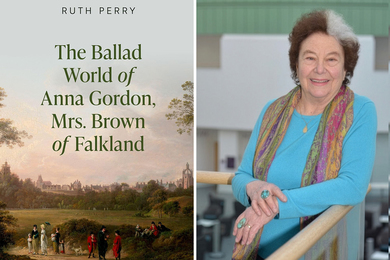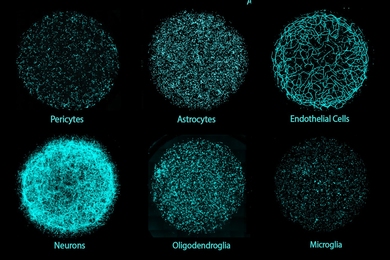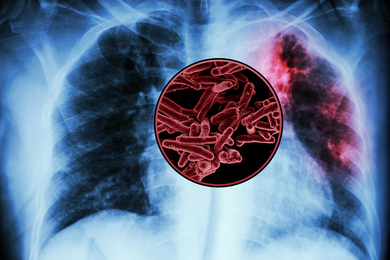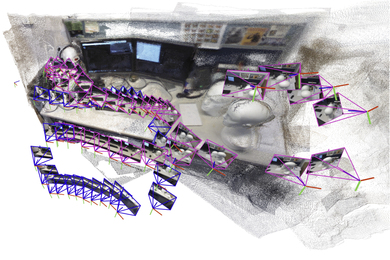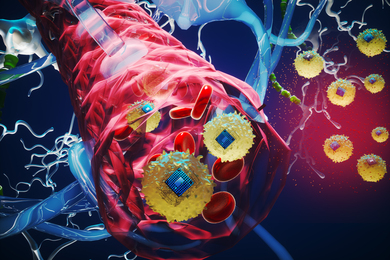In August, the Edgerton Center celebrated 20 years of hands-on learning. The center was founded in 1992 to carry on the legacy of Professor Harold “Doc” Edgerton, an innovator and a beloved teacher who encouraged students to try out their ideas. Professor J. Kim Vandiver, who helped found the center, reflects on the impact the Edgerton Center has had over the past 20 years.
Q. How is the legacy of Doc Edgerton made visible today in the MIT Edgerton Center?
A. Harold “Doc” Edgerton died in 1990. His family and I wanted the new Edgerton Center to carry on Doc’s legacy — not only to highlight his many contributions to high-speed photography, but to continue to support future generations of MIT students in "Learning by Doing."
Doc began Strobe Alley (in the fourth floor of Building 4) by hanging up pictures on the wall — his and everyone else’s. Today, we have Strobe Alley with interactive displays that highlight engineering and scientific principles, Doc’s equipment and fascinating high-speed photos.
As a graduate student in the spring of 1972, I asked Doc if I could take 6.163 (Strobe Project Lab) because I really wanted to learn how to do high-speed photography. The course was the beginning of a really long and wonderful friendship. We still teach Strobe Project Lab, a course that enables MIT students to get involved in high-speed photography. And every year in June we teach a short course for professionals in high-speed photography that Doc began long before I was his teaching assistant in 1972.
Inside the doors to the center we have many ways of supporting students and their projects.
We have fabrication facilities in N-51 and in Building 44, we offer a broad selection of classes in International Development (D-Lab), digital electronics and fabrication, strobe imaging; we guide students on teams and we support them with UROPs.
Also, the Edgerton Digital Collections, completed in 2011, is a really nice presence that reminds us of what Doc’s contribution was. It’s an online archive that makes accessible to the public much of his work, including all of his famous high-speed still photographs, high-speed movies, 7,000 pages from his notebooks and 10,000 photographs he took of people and places throughout his career.
Q. In what ways does the Edgerton Center impact and improve education at MIT?
A. Well, Doc Edgerton himself used to say that you don’t learn much from your successes. It’s your failures that really teach you something useful. So in order to have failures you have to go out and try things. I think the core emphasis of the Edgerton Center is what I call "experiential learning" and that’s going out and trying things. The way we do it at the Edgerton Center is to give students opportunities to try things that they’re motivated about, things that they’re excited and interested in. We do that with students who want to build solar cars and Formula SAE race cars and underwater vehicles. We give students a chance and the resources so they can go out and do it themselves.
Over the course of 20 years we’ve accumulated more and more resources to help students. In the first decade of the center, we began by working informally with students supporting them in their clubs and teams, and providing basic machine shop and fabrication facilities. In our second decade we began engaging MIT students in thinking about improving the lives of people in the developing world. More than 10 years ago, Amy Smith, who was a graduate student at the time, came to me with an idea of teaching a subject called “Designs for the Developing World.” Shortly after that first subject, I hired Amy at the Edgerton Center and she began building D-Lab, which engages MIT students in solving real problems in the developing world.
Today, D-Lab is an important part of the educational landscape of MIT with 13 classes enrolling more than 200 students. We are providing project-based learning with real-world impact for students. It is especially attractive to female students and has made a significant impact in attracting women to engineering. I take real pride in knowing that the Edgerton Center has helped to make D-Lab a success.
One of the intangible accomplishments of the Edgerton Center is that we have helped to make MIT a very attractive place for high school students who are thinking about where they want to go to college. When they come here to visit I want them to stop in at our facilities in N51. My vision is that when they walk around and see solar cars, wheelchairs in D-lab that have been designed for use in the developing world and see cool things that are happening in the International Design Center (IDC) they’ll say I want to come here, I want to be here. That is a part of what we have contributed to education; we’ve opened a window onto MIT and inspired students to be inventors and innovators and designers.
Q. Building on the success of the last 20 years, what is your vision for the next 20 years of the Edgerton Center?
A. Now, and most exciting, in the last three years we’ve begun to consolidate these hands-on resources in the same building as the MIT Museum (N51 and N52). This is now a go-to place for hands-on student invention, design and fabrication and my vision or hope for that is that this space will become a real hotbed for students to do innovative hands-on work.
D-Lab is 10 years old, but it is really just coming into its own now. It finally has an adequate space in the newly renovated building. In this shared space we’re going to have some of the best commercially available tools and equipment — including rapid prototyping technologies such as 3-D printing, laser-cutting machines and shop resources — that will benefit everyone, D-Lab, clubs and teams and the IDC. The D-Lab financial situation is becoming more stable through MIT financial support. It will be nice if D-Lab could become endowed sometime in the next few years.
The Edgerton Center has also been working on K-12 education for the past 15 years, primarily engaging with middle school teachers and kids in the Cambridge public schools and reaching out to the John D. O’Bryant School in Boston. We have our academic year program where teachers and their classes come to the Edgerton Center for three-hour hands-on science and engineering classes. We have summer programs and we are now engaged in exporting our curriculum to teachers and school systems in Massachusetts, Florida, Alaska and California. We support our curriculum with teacher professional development workshops hosted around the country. In the last eight years, we’ve also begun working on an approach to introduce engineering to the K-12 community through the work that Edgerton Instructor Ed Moriarty has been doing. If you stand back and look at what the Edgerton Center has done in K-12, you’d say “wow, that’s pretty neat.” We’ve really accomplished a lot.
Next, we would like to scale up and export our programs. I would like to see the Doc Edgerton model of "learning by doing" expanded through our programs to other parts of the country and inspire both K-12 and college students. Our model has had a significant impact on MIT and the world. I think Doc would be pleased.
Q. How is the legacy of Doc Edgerton made visible today in the MIT Edgerton Center?
A. Harold “Doc” Edgerton died in 1990. His family and I wanted the new Edgerton Center to carry on Doc’s legacy — not only to highlight his many contributions to high-speed photography, but to continue to support future generations of MIT students in "Learning by Doing."
Doc began Strobe Alley (in the fourth floor of Building 4) by hanging up pictures on the wall — his and everyone else’s. Today, we have Strobe Alley with interactive displays that highlight engineering and scientific principles, Doc’s equipment and fascinating high-speed photos.
As a graduate student in the spring of 1972, I asked Doc if I could take 6.163 (Strobe Project Lab) because I really wanted to learn how to do high-speed photography. The course was the beginning of a really long and wonderful friendship. We still teach Strobe Project Lab, a course that enables MIT students to get involved in high-speed photography. And every year in June we teach a short course for professionals in high-speed photography that Doc began long before I was his teaching assistant in 1972.
Inside the doors to the center we have many ways of supporting students and their projects.
We have fabrication facilities in N-51 and in Building 44, we offer a broad selection of classes in International Development (D-Lab), digital electronics and fabrication, strobe imaging; we guide students on teams and we support them with UROPs.
Also, the Edgerton Digital Collections, completed in 2011, is a really nice presence that reminds us of what Doc’s contribution was. It’s an online archive that makes accessible to the public much of his work, including all of his famous high-speed still photographs, high-speed movies, 7,000 pages from his notebooks and 10,000 photographs he took of people and places throughout his career.
Q. In what ways does the Edgerton Center impact and improve education at MIT?
A. Well, Doc Edgerton himself used to say that you don’t learn much from your successes. It’s your failures that really teach you something useful. So in order to have failures you have to go out and try things. I think the core emphasis of the Edgerton Center is what I call "experiential learning" and that’s going out and trying things. The way we do it at the Edgerton Center is to give students opportunities to try things that they’re motivated about, things that they’re excited and interested in. We do that with students who want to build solar cars and Formula SAE race cars and underwater vehicles. We give students a chance and the resources so they can go out and do it themselves.
Over the course of 20 years we’ve accumulated more and more resources to help students. In the first decade of the center, we began by working informally with students supporting them in their clubs and teams, and providing basic machine shop and fabrication facilities. In our second decade we began engaging MIT students in thinking about improving the lives of people in the developing world. More than 10 years ago, Amy Smith, who was a graduate student at the time, came to me with an idea of teaching a subject called “Designs for the Developing World.” Shortly after that first subject, I hired Amy at the Edgerton Center and she began building D-Lab, which engages MIT students in solving real problems in the developing world.
Today, D-Lab is an important part of the educational landscape of MIT with 13 classes enrolling more than 200 students. We are providing project-based learning with real-world impact for students. It is especially attractive to female students and has made a significant impact in attracting women to engineering. I take real pride in knowing that the Edgerton Center has helped to make D-Lab a success.
One of the intangible accomplishments of the Edgerton Center is that we have helped to make MIT a very attractive place for high school students who are thinking about where they want to go to college. When they come here to visit I want them to stop in at our facilities in N51. My vision is that when they walk around and see solar cars, wheelchairs in D-lab that have been designed for use in the developing world and see cool things that are happening in the International Design Center (IDC) they’ll say I want to come here, I want to be here. That is a part of what we have contributed to education; we’ve opened a window onto MIT and inspired students to be inventors and innovators and designers.
Q. Building on the success of the last 20 years, what is your vision for the next 20 years of the Edgerton Center?
A. Now, and most exciting, in the last three years we’ve begun to consolidate these hands-on resources in the same building as the MIT Museum (N51 and N52). This is now a go-to place for hands-on student invention, design and fabrication and my vision or hope for that is that this space will become a real hotbed for students to do innovative hands-on work.
- In February 2012, the International Design Center (IDC), part of the collaboration with the Singapore University for Technology and Design, opened its newly renovated space;
- In June 2012, D-Lab moved into a newly renovated space;
- Three years ago, the Edgerton Center’s student clubs and teams moved into workspace on the first floor;
- The MIT Museum is an important partner in the building and the Gordon Engineering Leadership program is conducting some of its activities in the building as well.
D-Lab is 10 years old, but it is really just coming into its own now. It finally has an adequate space in the newly renovated building. In this shared space we’re going to have some of the best commercially available tools and equipment — including rapid prototyping technologies such as 3-D printing, laser-cutting machines and shop resources — that will benefit everyone, D-Lab, clubs and teams and the IDC. The D-Lab financial situation is becoming more stable through MIT financial support. It will be nice if D-Lab could become endowed sometime in the next few years.
The Edgerton Center has also been working on K-12 education for the past 15 years, primarily engaging with middle school teachers and kids in the Cambridge public schools and reaching out to the John D. O’Bryant School in Boston. We have our academic year program where teachers and their classes come to the Edgerton Center for three-hour hands-on science and engineering classes. We have summer programs and we are now engaged in exporting our curriculum to teachers and school systems in Massachusetts, Florida, Alaska and California. We support our curriculum with teacher professional development workshops hosted around the country. In the last eight years, we’ve also begun working on an approach to introduce engineering to the K-12 community through the work that Edgerton Instructor Ed Moriarty has been doing. If you stand back and look at what the Edgerton Center has done in K-12, you’d say “wow, that’s pretty neat.” We’ve really accomplished a lot.
Next, we would like to scale up and export our programs. I would like to see the Doc Edgerton model of "learning by doing" expanded through our programs to other parts of the country and inspire both K-12 and college students. Our model has had a significant impact on MIT and the world. I think Doc would be pleased.











